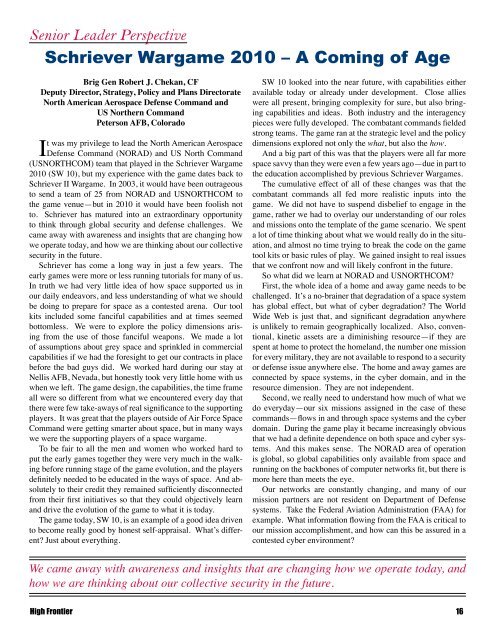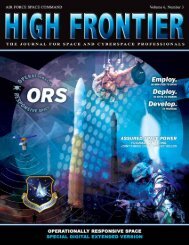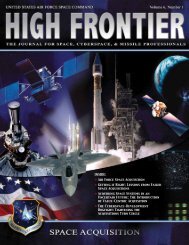Schriever Wargame 2010 - Air Force Space Command
Schriever Wargame 2010 - Air Force Space Command
Schriever Wargame 2010 - Air Force Space Command
- No tags were found...
Create successful ePaper yourself
Turn your PDF publications into a flip-book with our unique Google optimized e-Paper software.
Senior Leader Perspective<br />
<strong>Schriever</strong> <strong>Wargame</strong> <strong>2010</strong> – A Coming of Age<br />
Brig Gen Robert J. Chekan, CF<br />
Deputy Director, Strategy, Policy and Plans Directorate<br />
North American Aerospace Defense <strong>Command</strong> and<br />
US Northern <strong>Command</strong><br />
Peterson AFB, Colorado<br />
It was my privilege to lead the North American Aerospace<br />
Defense <strong>Command</strong> (NORAD) and US North <strong>Command</strong><br />
(USNORTHCOM) team that played in the <strong>Schriever</strong> <strong>Wargame</strong><br />
<strong>2010</strong> (SW 10), but my experience with the game dates back to<br />
<strong>Schriever</strong> II <strong>Wargame</strong>. In 2003, it would have been outrageous<br />
to send a team of 25 from NORAD and USNORTHCOM to<br />
the game venue—but in <strong>2010</strong> it would have been foolish not<br />
to. <strong>Schriever</strong> has matured into an extraordinary opportunity<br />
to think through global security and defense challenges. We<br />
came away with awareness and insights that are changing how<br />
we operate today, and how we are thinking about our collective<br />
security in the future.<br />
<strong>Schriever</strong> has come a long way in just a few years. The<br />
early games were more or less running tutorials for many of us.<br />
In truth we had very little idea of how space supported us in<br />
our daily endeavors, and less understanding of what we should<br />
be doing to prepare for space as a contested arena. Our tool<br />
kits included some fanciful capabilities and at times seemed<br />
bottomless. We were to explore the policy dimensions arising<br />
from the use of those fanciful weapons. We made a lot<br />
of assumptions about grey space and sprinkled in commercial<br />
capabilities if we had the foresight to get our contracts in place<br />
before the bad guys did. We worked hard during our stay at<br />
Nellis AFB, Nevada, but honestly took very little home with us<br />
when we left. The game design, the capabilities, the time frame<br />
all were so different from what we encountered every day that<br />
there were few take-aways of real significance to the supporting<br />
players. It was great that the players outside of <strong>Air</strong> <strong>Force</strong> <strong>Space</strong><br />
<strong>Command</strong> were getting smarter about space, but in many ways<br />
we were the supporting players of a space wargame.<br />
To be fair to all the men and women who worked hard to<br />
put the early games together they were very much in the walking<br />
before running stage of the game evolution, and the players<br />
definitely needed to be educated in the ways of space. And absolutely<br />
to their credit they remained sufficiently disconnected<br />
from their first initiatives so that they could objectively learn<br />
and drive the evolution of the game to what it is today.<br />
The game today, SW 10, is an example of a good idea driven<br />
to become really good by honest self-appraisal. What’s different<br />
Just about everything.<br />
SW 10 looked into the near future, with capabilities either<br />
available today or already under development. Close allies<br />
were all present, bringing complexity for sure, but also bringing<br />
capabilities and ideas. Both industry and the interagency<br />
pieces were fully developed. The combatant commands fielded<br />
strong teams. The game ran at the strategic level and the policy<br />
dimensions explored not only the what, but also the how.<br />
And a big part of this was that the players were all far more<br />
space savvy than they were even a few years ago—due in part to<br />
the education accomplished by previous <strong>Schriever</strong> <strong>Wargame</strong>s.<br />
The cumulative effect of all of these changes was that the<br />
combatant commands all fed more realistic inputs into the<br />
game. We did not have to suspend disbelief to engage in the<br />
game, rather we had to overlay our understanding of our roles<br />
and missions onto the template of the game scenario. We spent<br />
a lot of time thinking about what we would really do in the situation,<br />
and almost no time trying to break the code on the game<br />
tool kits or basic rules of play. We gained insight to real issues<br />
that we confront now and will likely confront in the future.<br />
So what did we learn at NORAD and USNORTHCOM<br />
First, the whole idea of a home and away game needs to be<br />
challenged. It’s a no-brainer that degradation of a space system<br />
has global effect, but what of cyber degradation The World<br />
Wide Web is just that, and significant degradation anywhere<br />
is unlikely to remain geographically localized. Also, conventional,<br />
kinetic assets are a diminishing resource—if they are<br />
spent at home to protect the homeland, the number one mission<br />
for every military, they are not available to respond to a security<br />
or defense issue anywhere else. The home and away games are<br />
connected by space systems, in the cyber domain, and in the<br />
resource dimension. They are not independent.<br />
Second, we really need to understand how much of what we<br />
do everyday—our six missions assigned in the case of these<br />
commands—flows in and through space systems and the cyber<br />
domain. During the game play it became increasingly obvious<br />
that we had a definite dependence on both space and cyber systems.<br />
And this makes sense. The NORAD area of operation<br />
is global, so global capabilities only available from space and<br />
running on the backbones of computer networks fit, but there is<br />
more here than meets the eye.<br />
Our networks are constantly changing, and many of our<br />
mission partners are not resident on Department of Defense<br />
systems. Take the Federal Aviation Administration (FAA) for<br />
example. What information flowing from the FAA is critical to<br />
our mission accomplishment, and how can this be assured in a<br />
contested cyber environment<br />
We came away with awareness and insights that are changing how we operate today, and<br />
how we are thinking about our collective security in the future.<br />
High Frontier 16











